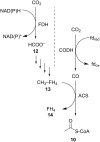Biocatalysis for the application of CO2 as a chemical feedstock
- PMID: 26734087
- PMCID: PMC4685893
- DOI: 10.3762/bjoc.11.259
Biocatalysis for the application of CO2 as a chemical feedstock
Abstract
Biocatalysts, capable of efficiently transforming CO2 into other more reduced forms of carbon, offer sustainable alternatives to current oxidative technologies that rely on diminishing natural fossil-fuel deposits. Enzymes that catalyse CO2 fixation steps in carbon assimilation pathways are promising catalysts for the sustainable transformation of this safe and renewable feedstock into central metabolites. These may be further converted into a wide range of fuels and commodity chemicals, through the multitude of known enzymatic reactions. The required reducing equivalents for the net carbon reductions may be drawn from solar energy, electricity or chemical oxidation, and delivered in vitro or through cellular mechanisms, while enzyme catalysis lowers the activation barriers of the CO2 transformations to make them more energy efficient. The development of technologies that treat CO2-transforming enzymes and other cellular components as modules that may be assembled into synthetic reaction circuits will facilitate the use of CO2 as a renewable chemical feedstock, greatly enabling a sustainable carbon bio-economy.
Keywords: CO2 transformation; RuBisCO; biocatalysis; carboxylase; formate dehydrogenase.
Figures














References
-
- Capellan-Pérez I, Mediavilla M, de Castro C, Carpintero Ó, Javier Miguel L. Energy. 2014;77:641. doi: 10.1016/j.energy.2014.09.063. - DOI
-
- Höök M, Tang X. Energy Policy. 2013;52:797. doi: 10.1016/j.enpol.2012.10.046. - DOI
-
- Stocker T F, Qin D, Plattner G-K, Tignor M, Allen S K, Boschung J, Nauels A, Xia Y, Bex V, Midgley P M. [Nov 11;2015 ];Climate change 2013: The Physical Science Basis. Working Group I Contribution to the IPCC 5th Assessment Report of the Intergovernmental Panel on Climate Change. 2013 Available from: http://www.ipcc.ch/report/ar5/wg1.
Publication types
LinkOut - more resources
Full Text Sources
Other Literature Sources
